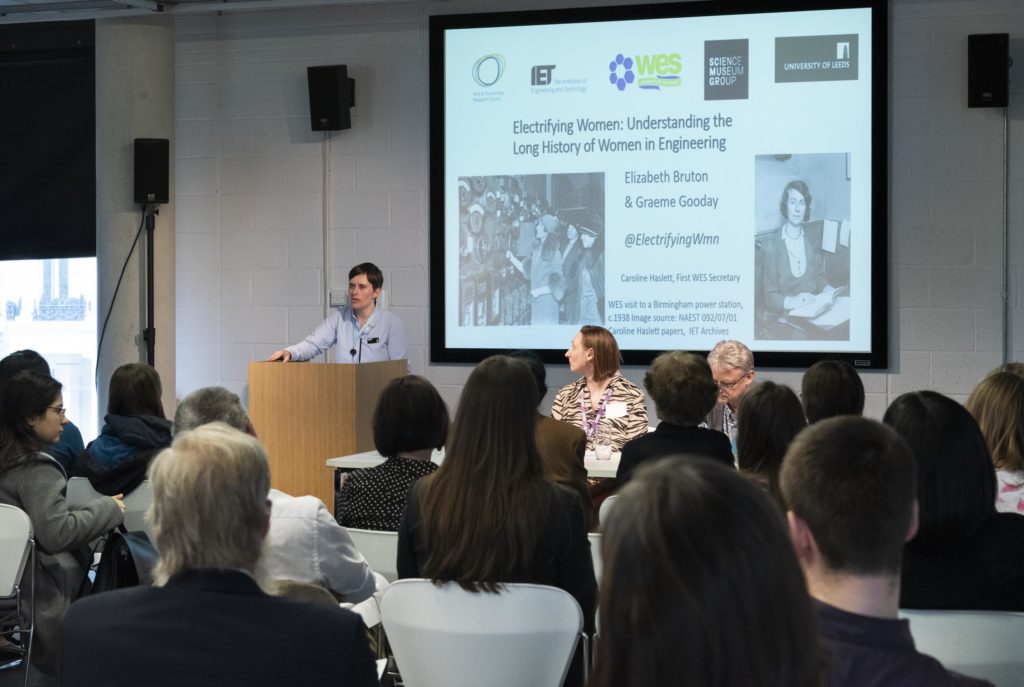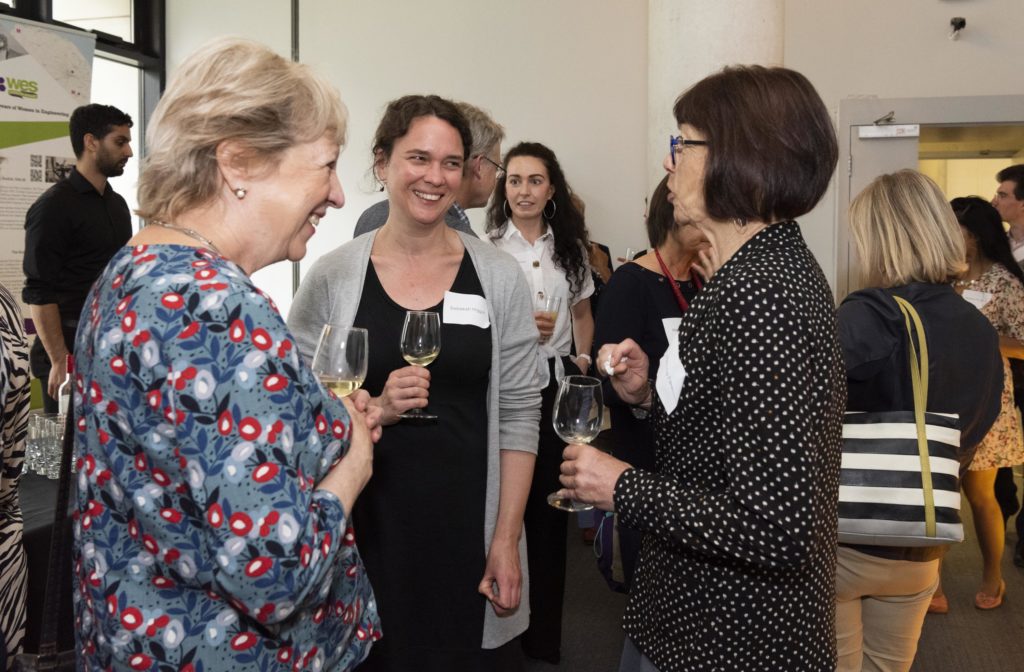By Emily Rees, Elizabeth Bruton and Graeme Gooday
In June 2019, to coincide with the centenary of the Women’s Engineering Society (WES), the Electrifying Women project was launched at the Science Museum, marking the start of an exciting journey into the history of women in engineering.
The primary team for the project consisted of Principal Investigator, Graeme Gooday (Professor of the History of Science and Technology at the University of Leeds), co-investigator Elizabeth (Liz) Bruton (Curator of Technology and Engineering at the Science Museum) and Research and Engagement Assistant Emily Rees (University of Leeds).
In this final blog post we reflect on what we have each learned from the project, from the various project partners and all those who attended the events and workshops that we ran. Without these participants the project would not have developed or succeeded as it did.
Funded by the Arts and Humanities Research Council and based primarily at the University of Leeds, the project’s aim was, in its broadest sense, to discover more previously unknown women who were involved in engineering and technical roles, to draw out these personal stories and bring them to new audiences, physically and online.
This was in the hope that this might then inspire girls and women to pursue education and career options in engineering and technical roles, to counteract the lack of women in engineering jobs (in 2019, 12% of practising engineers in the UK were women).
The project did not work alone but had several project partners, including WES, the Science Museum Group, the Institution of Engineering and Technology, amongst others. The Electrifying Women project aimed to help WES in their centenary celebrations, by bringing stories of their members and the organisations’ work to new audiences, of different ages and backgrounds.
The benefits of these collaborations were enormous, as Liz comments:
I think collaboration with the Women’s Engineering Society centenary project and individuals, especially independent researcher Dr Nina Baker, IET Archives and Library Manager Anne Locker, and Dr Alice White, digital editor and Wikimedian for Wellcome Collection, meant that our two projects became more than the sum of our parts. It meant we could dial into existing expertise and institutional partnerships and were able to collaborate on events and research and also publicity for various project activities.
Graeme highlights how, rather than simply providing lectures and talks, the project sought to work with our partners to take a creative approach to engagement, looking for fresh, new, inclusive and emotionally engaging ways to get people involved, such as theatrical drama, creative writing, and blogging.
The project wanted also to emphasise the careers of women in engineering before the founding of WES in 1919, thus building on the work Graeme did for his 2008 book ‘Domesticating Electricity’, which had discovered examples of Victorian women who had been involved in engineering through family and spousal connections, but who were not especially historically visible.
Over the course of the project, we were taken aback by the enthusiasm we received for the project and its objectives. The team travelled to venues across England, Scotland and Wales to meet different audiences and speak with them about the history of women in engineering, including schools, universities, local history groups, writing groups, and many more.
One of the most fruitful modes of engagement were the creative ones. For Emily, the creative writing workshops run by creative writing specialist Hannah Stone, in Leeds and London, were some of the most special events we ran. These gave other people the opportunity to create voices for the women of engineering history, who have more often than not been written out of the standardised historical narratives.
The anthology of this creative output From Fact to Fantasy (available to download here) is now a lasting testimony to the work that the writers put into finding lost voices. Hannah Stone’s guest blog post can also tell you more.
For Liz too, it was a creative venture that has made a lasting impact on her. Her favourite event was SHE, a public performance by final-year theatre and performance students at the University of Leeds, which was inspired by a presentation on the Electrifying Women project by Graeme.

These students devised, wrote, and performed SHE as a play with music. This promised to teach us about the ‘bold and brilliant’ women who fought for ‘rights and equality’ so that we may all grow, learn, prosper and thrive.
Supervised by Dr George Rodosthenous, the students undertook research for SHE in the Feminist Archive North holdings of Women in Science and Engineering to find stories of UK and US women who had innovated in technical and scientific fields.
If you’re interested, the performance is free to view online and you can read Liz’s review of the performance here.
For Graeme, a highlight of the project was talking to international engineering undergraduates in Loughborough University’s WES group about their experiences as women starting out in engineering, and to share with them the history of women in engineering in Loughborough and elsewhere.
Graeme said of this:
They showed such enormous enthusiasm to share experiences and knowledge, with great reflections and empathy with others struggling – and had a positive outlook, informed by historical awareness.
You can find the powerpoint slides from this workshop at Loughborough, and many others, on our Events page.
An important objective of the project was that there would be lasting resources developed out of the engagement activities and that other people would be able to continue the work of the project if they wanted to.
For this, the project’s website has become a portal for the various resources that have been created, which was one of the main tasks undertaken by Emily. These resources include short videos presented by Emily on the five key themes of the history of women in engineering.
There are volunteering packs, which include information on running volunteer events, writing blog posts, and primary research (made with the assistance of Dr Nina Baker, a historian of women in engineering and one of the project’s key collaborators). You can also find a selection of worksheets and resources for those interested in running their own creative writing workshops on the theme of women in engineering.
Working with project partner, the IET archives – which hold collections for WES, the Electrical Association for Women and Caroline Haslett’s papers – we ran an introductory session to using these archives. To encourage more use of their varied collections, there are now source papers, aimed at educators and students, available here on our website, which include primary material from the IET archives.
As the project draws to a close, we are now extremely keen to encourage anyone interested in spreading the history of women in engineering to new audiences to use our collection of resources in any way they wish.
Making sure that our research is visible and accessible was another vital strand in the project. The two Wikithons run by the project meant members of the public could be trained in how to edit Wikipedia and create pages and improve existing pages for historical women in engineering.
Thanks to these sessions, the leading founder of WES Lady Katharine Parsons now has her own Wikipedia page. Furthermore, research that has made its way into our blog posts, such as on Henrietta Vansittart, which have now been used to improve her existing Wikipedia page.
Graeme has found that the lively growth in Wikipedia writing on women in engineering supported by the Electrifying Women project “is an unexpected and marvellous development.” You can read more about the Wikithon in London in this blog post by Emily.
There is, however, more work to be done to find out more about women in engineering’s past, and to share it more widely. As the project developed, it became apparent that some audiences needed more attention, especially to fulfil the aim of promoting engineering as a career to young girls. For this, working with schools will be fundamental, to produce more educational resources and activities that can be used by teachers.
There are also more events and activities that can be run, such as to commemorate Caroline Haslett’s 125th birthday on 17th August this year, which we know a history group in Crawley are looking to do. The research on this topic is also still a work in progress – many more stories can still be uncovered – not least in the IET archives, mentioned above.
We’d like to thank everyone who has been involved with us in the project – without you none of this would have been possible. We encourage you now to continue to help us with this work, using the resources provided.


